L-Methioninol is widely utilized in research focused on:
- Flavor and Fragrance Industry: This compound is used as a flavoring agent due to its pleasant aroma, enhancing the sensory profile of food products and perfumes.
- Pharmaceutical Applications: It serves as a precursor in the synthesis of various pharmaceuticals, particularly those targeting metabolic disorders, providing a pathway for drug development.
- Biochemical Research: Researchers utilize L-Methioninol in studies related to amino acid metabolism, helping to understand its role in cellular processes and potential therapeutic applications.
- Antioxidant Properties: Its antioxidant characteristics make it valuable in cosmetic formulations, protecting skin from oxidative stress and promoting healthier skin.
- Animal Nutrition: Used as a dietary supplement in animal feed, it supports growth and overall health in livestock, offering a natural alternative to synthetic additives.
General Information
Properties
Safety and Regulations
Applications
L-Methioninol is widely utilized in research focused on:
- Flavor and Fragrance Industry: This compound is used as a flavoring agent due to its pleasant aroma, enhancing the sensory profile of food products and perfumes.
- Pharmaceutical Applications: It serves as a precursor in the synthesis of various pharmaceuticals, particularly those targeting metabolic disorders, providing a pathway for drug development.
- Biochemical Research: Researchers utilize L-Methioninol in studies related to amino acid metabolism, helping to understand its role in cellular processes and potential therapeutic applications.
- Antioxidant Properties: Its antioxidant characteristics make it valuable in cosmetic formulations, protecting skin from oxidative stress and promoting healthier skin.
- Animal Nutrition: Used as a dietary supplement in animal feed, it supports growth and overall health in livestock, offering a natural alternative to synthetic additives.
Documents
Safety Data Sheets (SDS)
The SDS provides comprehensive safety information on handling, storage, and disposal of the product.
Product Specification (PS)
The PS provides a comprehensive breakdown of the product’s properties, including chemical composition, physical state, purity, and storage requirements. It also details acceptable quality ranges and the product's intended applications.
Certificates of Analysis (COA)
Search for Certificates of Analysis (COA) by entering the products Lot Number. Lot and Batch Numbers can be found on a product’s label following the words ‘Lot’ or ‘Batch’.
*Catalog Number
*Lot Number
Certificates Of Origin (COO)
This COO confirms the country where the product was manufactured, and also details the materials and components used in it and whether it is derived from natural, synthetic, or other specific sources. This certificate may be required for customs, trade, and regulatory compliance.
*Catalog Number
*Lot Number
Safety Data Sheets (SDS)
The SDS provides comprehensive safety information on handling, storage, and disposal of the product.
DownloadProduct Specification (PS)
The PS provides a comprehensive breakdown of the product’s properties, including chemical composition, physical state, purity, and storage requirements. It also details acceptable quality ranges and the product's intended applications.
DownloadCertificates of Analysis (COA)
Search for Certificates of Analysis (COA) by entering the products Lot Number. Lot and Batch Numbers can be found on a product’s label following the words ‘Lot’ or ‘Batch’.
*Catalog Number
*Lot Number
Certificates Of Origin (COO)
This COO confirms the country where the product was manufactured, and also details the materials and components used in it and whether it is derived from natural, synthetic, or other specific sources. This certificate may be required for customs, trade, and regulatory compliance.


